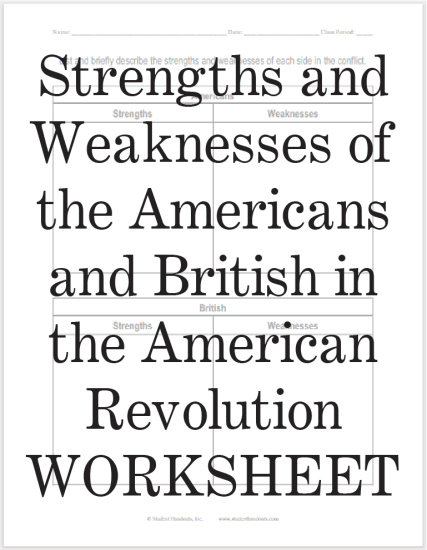Students are asked to complete this blank chart by listing the strengths and weaknesses of both the Americans and the British in the U.S. Revolutionary War. Click
here to print. Answers will vary.
The American Revolutionary War, which took place from 1775 to 1783, featured both strengths and weaknesses for the American colonists and the British.
Strengths of the American Colonists:
- Motivation and Cause: The American colonists were highly motivated by their desire for independence and the defense of their rights. This strong ideological cause fueled their determination.
- Knowledge of the Terrain: American forces had an intimate knowledge of the local terrain, which was often difficult for the British to navigate. This allowed for effective guerrilla tactics and ambushes.
- Leadership: The American colonists had skilled military leaders, such as George Washington and Nathanael Greene, who provided competent command.
- Foreign Support: Over time, the Americans received crucial support from foreign powers, particularly France, which provided troops, naval assistance, and financial aid.
- Resourcefulness: American forces were often resourceful, using hit-and-run tactics, employing irregular warfare, and adapting to difficult circumstances.
Weaknesses of the American Colonists:
- Lack of a Regular Army: The American forces lacked a professional standing army, which made it challenging to train and maintain a consistent force.
- Limited Resources: The American colonists faced shortages of essential resources, including weapons, ammunition, and uniforms.
- Political Divisions: There were political divisions within the American colonies, with loyalists or Tories supporting the British Crown. This internal strife weakened the revolutionary cause.
- Inferior Navy: The American navy was much smaller and less powerful than the British Royal Navy.
British Strengths:
- Professional Army and Navy: The British had a highly trained and disciplined military, which included a powerful navy. They possessed more experienced troops and officers.
- Financial Resources: Britain had a stronger economy and greater financial resources to fund the war effort.
- Logistical Support: The British had better supply lines, which ensured that their troops were more consistently equipped and fed.
- Allies: Britain had the support of loyalists in the American colonies and Native American allies.
British Weaknesses:
- Distance and Supply Lines: The war was fought thousands of miles from Britain, making it challenging to maintain supply lines and communication.
- Public Support: There was limited public support for the war in Britain, and many British citizens were opposed to the conflict.
- Familiarity with the Terrain: British forces were often unfamiliar with the American terrain, and the vastness of the American continent made it difficult to control and occupy.
- Overextension: The British Empire was engaged in conflicts worldwide, and the American Revolutionary War became an additional strain on their resources and military.
Ultimately, the American colonists' strong motivation and the support they garnered over time played a crucial role in their victory. The British, despite their military and economic advantages, faced significant challenges in a protracted conflict so far from home.











